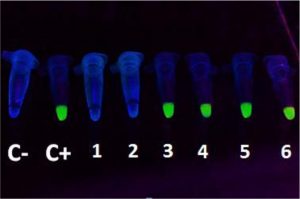This examine aimed to the serological and molecular analysis of Toxoplasma gondii infections and associated threat components in sufferers with thalassemia main and wholesome controls.
This case-management examine was carried out in Shahrekord University of Medical Sciences, Shahrekord, west of Iran from Jan 2014 to Jan 2015. Overall, 235 sufferers with thalassemia main and 235 wholesome controls had been enrolled. Assessment of anti-Toxoplasma antibodies in sera samples was carried out utilizing industrial ELISA kits. In order to the molecular examine of T. gondii in blood samples, a comparatively new molecular assay, LAMP method primarily based on Toxoplasma SAG1 gene was performed for the primary time. The specificity of LAMP outer primers for the T. gondii detection was confirmed by sequencing the purified PCR product.
51.9% of thalassemia sufferers and 34.8% of wholesome controls had been optimistic for anti-Toxoplasma IgG antibodies, which the distinction was statistically important (P<0.01). In phrases of anti-Toxoplasma IgM antibody, 3.4% of thalassemia sufferers and 2.1% of wholesome people had been optimistic, which the distinction was not statistically important (P=1). Based on SAG1-LAMP, 9.78% of the thalassemia sufferers and 5.95% of wholesome controls had been optimistic for T. gondii DNA, which the distinction was not statistically important (P≤0.230).
Thalassemia sufferers, most likely as a consequence of repeated blood transfusion and consequently, immune deficiency, are in danger of transmitting Toxoplasma an infection greater than wholesome folks. Therefore, screening of Toxoplasma an infection in blood transfusion facilities could also be efficient in the prevention of toxoplasmosis in these sufferers.

Role of insulin-like development factor-1 in pores and skin tags: a scientific, genetic and immunohistochemical examine in a pattern of Egyptian sufferers.
Background: Skin tags (STs) are benign connective tissue neoplasms, in which insulin-like development issue -1 (IGF-1) has a mitogenic and antiapoptotic exercise.
Purpose: We aimed to review for the primary time, the potential position of IGF-1 (CA) 19 and rs6214 gene polymorphisms, and its tissue immunoreactivity in the pathogenesis of STs.
Patients and strategies: This case-management examine included 40 ST sufferers and 20 controls. We looked for (CA) 19 single-nucleotide polymorphism (SNP) utilizing conversional PCR and for rs6214 gene polymorphism utilizing real-time PCR. IGF-1 tissue immunoreactivity was investigated utilizing polyclonal IGF-1 antibody.
Results: IGF-1 immunoreactivity confirmed considerably robust upregulation in dermis (p=0.002) and dermal elements (endothelial cells [p=0.038] and fibroblasts [p=0.004]) of excised STs than management pores and skin. TT and CT rs6214 genotypes and its T allele had been considerably related to STs (p=0.006 and P=0.002, respectively).
Also (<192 bp) and 192-194 bp (CA) 19 genotypes had been considerably predominant in ST sufferers than controls (p=0.013).
These Four genotypes had been considerably related to improvement of a number of STs and epidermal IGF-1 tissue immunoreactivity in studied sufferers. Conclusions: IGF-1 (CA) 19 and rs6214 gene polymorphisms could contribute to a predisposition of STs in Egyptian sufferers, the position of which might be mediated by native upregulation of IGF-1 in cutaneous tissues.
